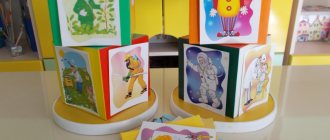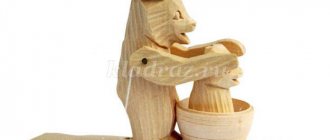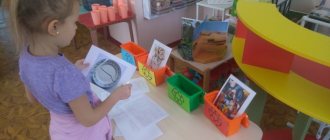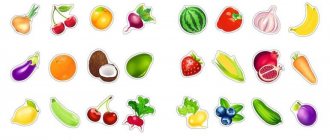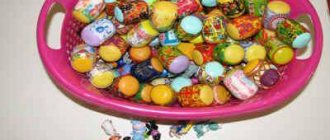Consultation “Didactic materials in the work of a preschool teacher”
Galia
Consultation “Didactic materials in the work of a preschool teacher”
Didactic materials in the work of a preschool teacher
“Leading activity is activity, the implementation of which determines the emergence and formation of the basic mental new formations of a person at a given stage of development of his personality.” [3]
L. S. Vygotsky laid the foundations for ideas about leading activity.
Further, the hypothesis about the leading type of activity was expressed in 1944-45. A. N. Leontiev and was developed in of D. B. Elkonina, V.V. Davydova and others, according to this hypothesis, leading activity is a criterion for the periodization of mental development, an indicator of the child’s psychological age. According to this periodization, the leading activity of preschool children is play.
“Game is the leading type of activity for a preschool child”
.
“Play is an activity in which a child first emotionally and then intellectually masters the entire system of human relationships. A game is a special form of mastering reality by reproducing and modeling it.” In order for the game to educate the child and bring positive emotions during the game, educators select and create special teaching aids . With the help of didactic games, children develop, educate and learn during their natural activities. [4]
To create such a game, didactic materials .
What is the importance of didactic material in kindergarten ?
According to the Federal State Educational Standard for Preschool Education, the developing subject-spatial environment in which children find themselves must, first of all, be content-rich. That is, the educational space must be equipped with means of training and education , appropriate materials ( didactic , including consumable gaming, sports, recreational equipment and inventory. In this context, properly selected didactic materials . They are the teacher’s assistants for the development of the child’s abilities and learning something new.Such materials should be aesthetically attractive, pleasant to the touch, colorful, bright to stimulate interest and attract the child’s attention.
What is didactic material ?
“ Didactic material is a special type of teaching aids, the use of which helps to enhance the cognitive activity of students and save learning time.” [2]
Didactic material , educational material - a type of visual teaching aids (maps, tables, reagents, plants, etc., distributed to students for independent work in class or at home or demonstrated by a teacher; didactic material is also called collections of tasks and exercises.
Didactic materials in preschool institutions are materials that are simple in content and aimed at learning through play, complement it and are used in the process of its implementation (educational games, various cards, drawings, diagrams, presentations)
.
What are didactic materials in the form of a game ? During the game, the child receives a variety of information and learns new skills and knowledge. Play is a part of a child’s life, but through the process of properly selected entertainment, the young explorer will learn. The game brings the child pleasure from the process itself; the result is not important for him. Every game has rules, and the child learns them, remembers them, and thereby learns.
During the game, the child acquires new knowledge and skills.
didactic materials should have : variability of forms and methods of presenting material ; focus on proactive learning; engaging content; focus on developing thinking abilities.
Purposes of using didactic materials :
development of fine motor skills and tactile sensitivity;
formation of ideas about the external properties of objects (shape, color, size, position in space)
;
creating a positive emotional mood;
development of cognitive processes (memory, attention, thinking)
;
development of speech skills;
teaching numeracy and literacy.
All didactic materials are divided into several types:
Subject-shaped manuals reveal the most general, essential characteristics of the objects being studied. Natural (made from natural materials )
and three-dimensional
didactic materials :
Natural visual aids are aids created from natural materials .
Three-dimensional didactic materials are manuals that clearly demonstrate the process or structure of the subject under discussion (models, layouts, dummies, etc.)
.
Iconic didactic materials - designed as material in pictures , handouts , demonstration material (stands, posters, multimedia presentations, etc.)
Figurative-symbolic visual aids are materials that allow children to remember the image of the object being studied as a whole and abstract from particulars (subject and subject pictures, various cards, portraits, applications, photos, films, etc.).
Conventionally symbolic didactic material is material that reveals or examines particulars or details according to one or more active characteristics.
didactic materials for kindergarten yourself. The process of creating manuals includes a number of stages:
Statement of the goal - what exactly the developed didactic material . The benefit must be age-appropriate , understandable and accessible.
Selecting a topic within which teaching material (for example, “Primary colors”
).
Think over the concept of the aid - what type of visual aid is being created: cards, a stand, a poster or an entire game.
Select suitable materials to create a visual aid - the material should be bright so that the child can easily remember what was depicted. The material should not be brittle or easily breakable. The material should be as safe as possible for preschoolers. The materials used must be hypoallergenic. The material must withstand sanitary treatment .
Assembling the material - the information depicted or presented must characterize the world around us and correspond to reality; the didactic material was beautifully and neatly designed.
Timely planning of the use of created didactic material .
The selection of didactic materials depends not only on the material equipment of the preschool educational institution , but also on the set goals of educational work , methods, age of the children, as well as on the characteristic features of individual educational educational institutions.
The use of didactic materials in kindergarten helps to develop the cognitive, communicative and creative abilities of preschoolers of all age groups. When applying benefits, the teacher should remember the wide range of choices for their presentation. Making didactic materials with your own hands allows you to implement various pedagogical ideas in the educational process of a preschool educational institution. The main thing is to correctly develop the manuals , think them through and arrange them. A variety of methodological recommendations and the author’s own imagination will help with this. [9]
Bibliography:
1. Kulikovskaya T. “ Didactic material “The World Around Us”, “Animals of the Arctic and Antarctic”
2. Moiseev V. B. Information technologies in the higher education system. - Penza, 2002. p. 94)
3. Popular psychological encyclopedia. — M.: Eksmo. S. S. Stepanov. 2005. (p. 102)
4. Professional education. Dictionary. Key concepts, term, current vocabulary. - M.: NMC SPO. S. M. Vishnyakova. 1999.
5. Psychological and pedagogical dictionary. / Comp. Rapatsevich E. S. – Minsk, 2006, p. 184-185.
6. The role of didactic materials in the learning process [access mode: https://letopisi.ru/index.php]
7. https://www.montessori-center.ru/kursy-i-seminary_744/didakticheskij-material/
8. https://info-4all.ru/obrazovanie/chto-takoe-didakticheskie-materiali/
9. https://melkie.net/metodicheskie-razrabotki/didakticheskiy-material-dlya-detskogo-sada-svoimi-rukami.html
10. https://psychlib.ru/mgppu/ode/ode-001.htm#$p193
Do-it-yourself didactic games and manuals for kindergarten
DIY didactic games
Hello, dear colleagues, friends! I want to share with you ideas for making games with my own hands (these games were made by me over the past three years), I wanted to collect all the games in one section.
Layout "Pets"
was made from waste material (cardboard and newspaper tubes) for preschool children.
You can view the master class on making a model
here Goal: to consolidate ideas about pets. Objectives: Educational: To consolidate children's knowledge about domestic animals.
Note the characteristic features of animals. Strengthen the ability to compare, find similarities and differences. To develop the ability to distinguish between animals and their young. Develop the skill of writing a short story about animals. Educational: Develop children's memory, thinking, imagination. To develop children's interest in living nature and emotional responsiveness. Educational: To instill in children a love for their native land. To instill in children a kind attitude towards animals, to create a desire to help them. Model "Miller's Yard"
Miller's yard.
Master class Purpose: the layout is intended for direct educational and play activities of children of senior preschool age, for interior decoration. The goal is to promote the emergence and development of emotional and cognitive interest in the historical and cultural heritage of Russia. Objectives: 1. To consolidate knowledge about the characteristics of peasant labor and the profession of a miller.
2. Expand the understanding of the life of a peasant family in Rus'. Didactic game: “Feed the bun”
Goal: development of fine motor skills and tactile sensitivity. Equipment: small plastic jars with lids, beans.
Making a manual: depict a kolobok (or other character) from self-adhesive paper on the lid. Make a hole in the mouth with a stationery knife (it’s convenient to cut a hole if you twist the knife in a circle) “Fisherman”
There are many variations of this game. It can be complicated depending on the age of the children. I offer my options with children of the younger and middle groups. A child catches a fish with a fishing rod. 1. “What size and color is it?” Purpose: to exercise children in determining the size of the fish; consolidate knowledge of color. 2. “Where does it grow?” Purpose: to learn to classify objects according to the topics “Vegetables”, “Fruits”. 3. “Who lives where” Purpose: to learn to classify objects according to the topics “Domestic, wild animals” 4. “Where is whose mother” (additional cards with images of animals are needed) Purpose: to learn to select domestic and wild animals, name them correctly. 5. “The fourth odd one” Purpose: to teach how to classify objects by topic.
"Carnations and Rubber Bands"
For this game you need wooden plywood, stationery nails and rubber bands. Purpose: for the development of fine motor skills, visual, color and spatial perception, imagination;; consolidate knowledge of various types of geometric shapes and lines.
Game "Funny Dwarfs".
Goal: learn the names of the days of the week and their order, consolidate the concepts of yesterday, today, tomorrow.
First option. “Which gnome is gone.” Children close their eyes, the teacher removes one gnome. Children open their eyes and guess which gnome ran away. Second option. Children close their eyes, the teacher changes the order of the gnomes. Children open their eyes and place them in the correct sequence. Third option. We teach together with the children yesterday and tomorrow, if today is Monday, yesterday and tomorrow, if today is Tuesday, etc. goal: to develop tactile perception in children; enrich children's active vocabulary with new words, develop memory, attention, imagination, imaginative thinking; fine motor skills. "Tactile caps"
For the game I took: - bottled water caps; - different textured fabric, fur, sandpaper, leather, beads; - glue. Progress of work: - I cut out circles of the same size as the lids from various materials and glued them on. How to play: - Put all the caps in an opaque bag and ask the child to pull out a cap with a smooth texture, etc. - “Find a pair” - “Find dissimilar caps” (for example, fur and leather) - “Guess what (who) it looks like” - “Guess who I am” (red fur - fox, sandpaper - hedgehog, smooth skin - frog)
Educational game “Squares with a secret”
Goal: to enrich children’s active vocabulary with new words, to develop memory, attention, and fine motor skills. The sense of touch or tactile perception plays an important role in development. And it is associated with the development of imagination, imaginative thinking and creative speech abilities in children. And training fine motor skills of the fingers stimulates the timely development of speech skills. Each “square” is sewn from opaque fabric. It's a flat 6x6 pad with a cardboard frame inside and one small object in the center. There should be a pair of “squares” with identical objects inside. This game is multifunctional. The first option is “Find a pair.” The child feels the “square” and finds a match for it. Second option. It is necessary to divide the “squares” into two piles so that each does not contain the same ones. Place the first pile on the table, and distribute the “squares” from the second to the players equally. Players place their “squares” in front of them. The adult becomes the leader, but can also take part in the game. The presenter takes the “square”, feels it and describes its contents in words. For example, he says that there is a large smooth stone there. The player who has the paired square takes it for himself. The first person to get a pair for each of their “squares” wins.
Educational game "Candy"
Goal: learn to differentiate non-speech noises, find identical-sounding “candy,” develop logical thinking, attentiveness, and memory. Hearing is no less important a tool for understanding the world around us than sight and touch. The ability to hear and distinguish sounds also requires constant training. The better a child hears, the faster he will learn to understand the meaning of what is being said to him and the faster verbal communication will become an effective way for him to gain new knowledge. Each “candy” is made from kinder surprise. The “candies” are filled with various fillings that produce a certain sound when shaken, and are lined with bright fabric. A pair consists of “candies” that make the same sound when shaken, with the same filling. These could be beads, cereals, paper clips, etc. The first option is “Find the same one.” Two people are playing. “Candy” is laid out on the table, the player takes any one “candy” and rattles it, and then takes another one and also shakes it. You cannot take more than two “candies”. If the sound is different, then the player puts each one in its original place, and the turn passes to the next player. If the sound is the same, then the player takes both candies for himself and gets the right to immediately make another move. The game continues until there are no more candies on the table. And this is a similar game to “coffee girls”, the manual is made from chocolate eggs and covered with thermal film
Game for developing fine motor skills “Surprise Box”
"Box of Feelings"
This manual is made from a shoe box. Two circles are cut out on the lid, the sleeves are sewn from cotton fabric, the whole box is covered with self-adhesive. I would be glad if anyone gets some ideas! There are so many interesting ideas on the site, I want to do a lot, but I don’t have enough time for all the time! I wish everyone creative success, ideas and more time to implement them! Thanks to everyone who looked at the page and watched to the end!
We recommend watching:
Do-it-yourself didactic game for kindergarten “Know-It-All” Didactic manual “Grandfather Planted a Turnip” Games with clothespins. Didactic manual “Who eats what” Do-it-yourself educational toys “Balls - Smeshariki”
Similar articles:
Do-it-yourself didactic games for preschoolers on the topic “Sense Organs”
DIY didactic game for preschoolers. World of flora and fauna
Do-it-yourself didactic game for kindergarten on the topic “Transport”
DIY didactic game for preschoolers
Didactic game for children 4-7 years old “Fairytale Hotel”
Electronic manuals
What are educational materials in electronic form? These are video lessons, various presentations, electronic audio and video books.
The most effective of all electronic aids are video lessons; by watching such material, most of the information is absorbed. With the help of a video lesson, the student can independently study the topic; this option is convenient if the student is ill or when learning remotely.
Such materials are supplemented with tables, diagrams, photographs, which makes the learning process more fun.
So, when using electronic materials, there is no need for a whole bunch of paper notes and visual aids, but naturally this does not replace them completely.
With distance learning, you have the opportunity to ask questions to the teacher online, complete practical work and submit it for testing.
The presence of electronic materials in the modern world is necessary and plays a huge role in the learning process:
- the efficiency of mastering the material increases;
- searching for information takes less time;
- children are interested in learning the subject;
- You can study the lesson yourself;
- can be used for a large audience;
- it is possible to clearly explain new information.
